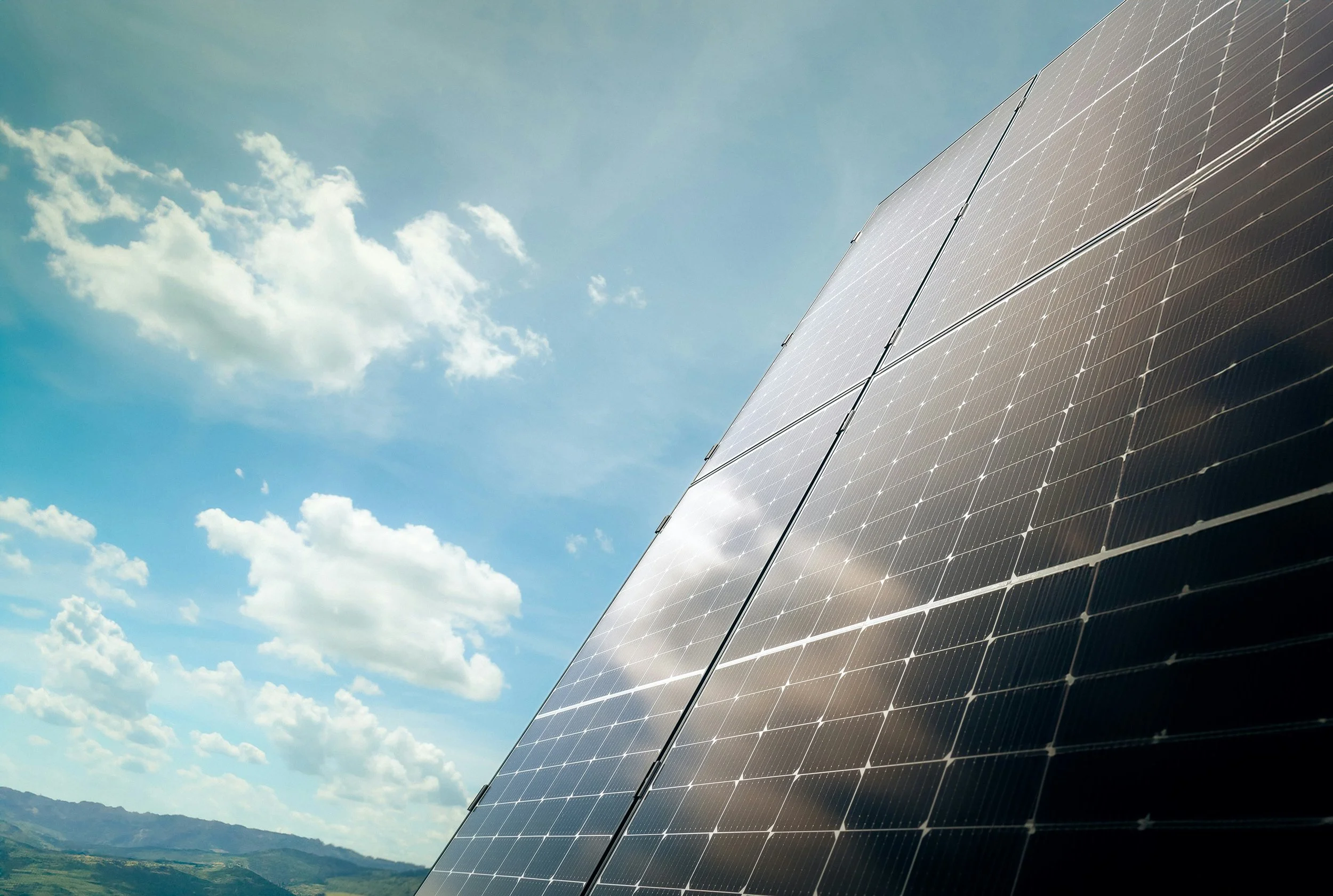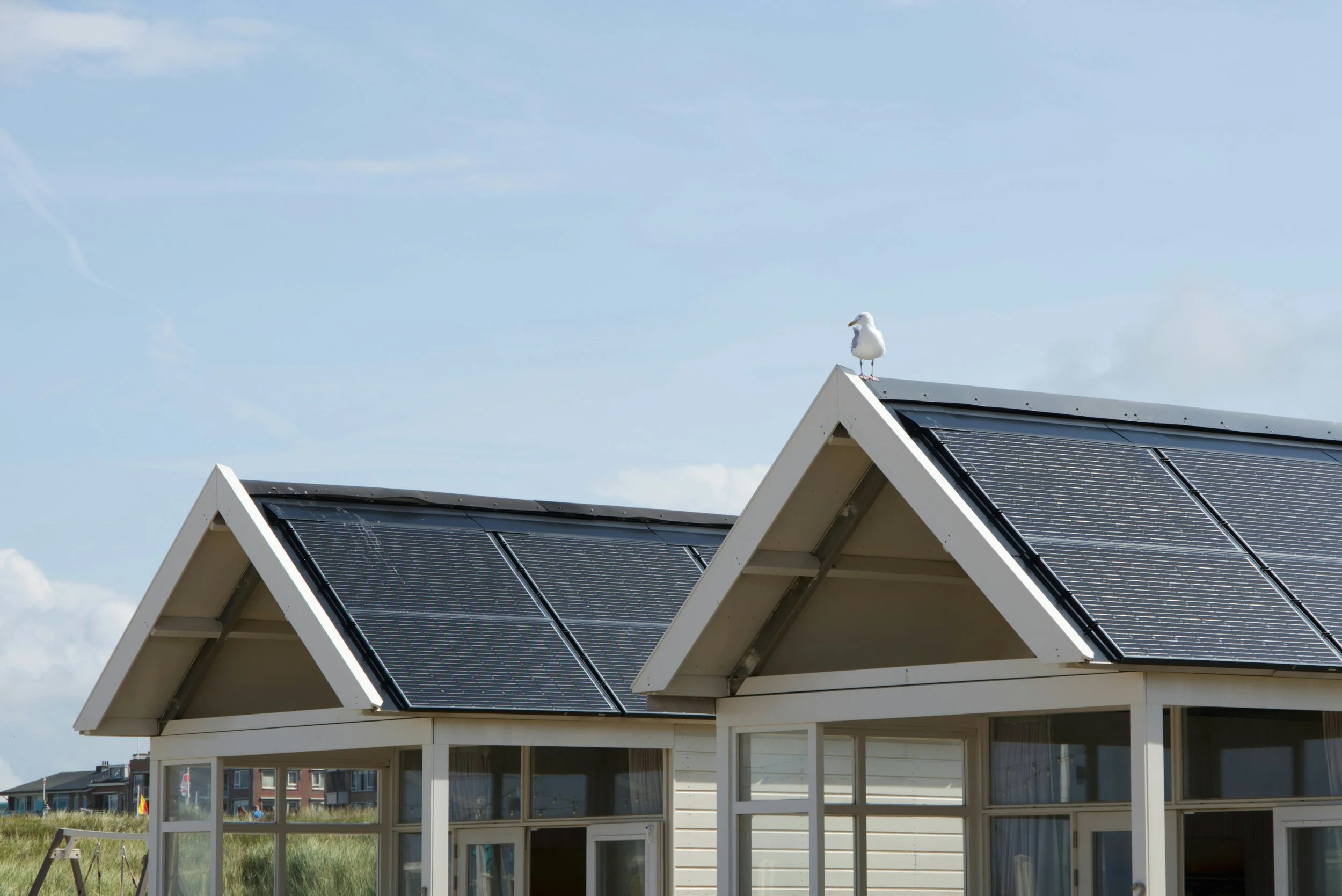Solar Panels
What Are Solar Panels?
Solar panels (also called photovoltaic or PV panels) are devices that convert sunlight into electricity. They are made up of many solar cells, typically made from silicon, that capture sunlight and turn it into direct current (DC) electricity.
How Do Solar Panels Work?
Photovoltaic Effect: Solar cells absorb photons (light particles) from the sun, which excite electrons in the silicon.
Electric Current: These excited electrons flow through the material, creating an electric current.
Inverter Conversion: Since the electricity generated is DC, an inverter converts it to alternating current (AC), which powers homes and businesses.
Usage or Storage: The electricity is either used immediately, stored in batteries, or sent back to the grid.
Types of Solar Panels
Monocrystalline: Made from single-crystal silicon, known for high efficiency and sleek black appearance. Usually more expensive.
Polycrystalline: Made from multiple silicon crystals, slightly less efficient but more affordable. Typically, blue in color.
Thin-film: Made from layers of photovoltaic material on flexible substrates. Less efficient, but lightweight and versatile for some applications.
Benefits of Solar Panels
Renewable Energy: Solar is a clean, inexhaustible energy source.
Lower Electricity Bills: Generate your own electricity and reduce reliance on the grid.
Environmentally Friendly: Reduces greenhouse gas emissions.
Energy Independence: Less affected by fossil fuel price volatility.
Incentives: Many governments offer tax credits, rebates, and incentives to install solar.
Costs and Considerations
Installation Cost: Has dropped dramatically over the past decade. Average residential systems in the U.S. cost between $15,000–$30,000 before incentives.
Lifespan: Typically, 25–30 years with performance warranties around 25 years.
Maintenance: Generally low maintenance; occasional cleaning and inspections.
Roof Suitability: Needs good sun exposure, usually south-facing, with minimal shading.
Battery Storage: Adding batteries (like Tesla Powerwall) allows for energy use at night but adds cost.
Trends & Innovations
Solar + Storage: More homes are adding battery storage for backup power.
Building-Integrated PV: Solar cells integrated into roof shingles, windows, or building materials.
Improved Efficiency: New materials and designs (perovskite cells, bifacial panels) boost output.
Community Solar: Shared solar projects for renters or those without ideal roofs.
Quick FAQs
Do solar panels work on cloudy days? Yes, but output is reduced.
Can solar panels power an entire home? Often yes, depending on system size and energy use.
What happens in a power outage? Most grid-tied systems shut down for safety unless paired with batteries.
Generally, Solar Panels Increase Home Value
Positive Buyer Appeal: Many buyers see solar panels as a valuable upgrade because they reduce electricity bills.
Energy Savings: Homes with solar often have lower utility costs, which can be a strong selling point.
Green Appeal: Environmentally conscious buyers appreciate the eco-friendly aspect.
2. How Much Value Do Solar Panels Add?
According to studies (like from Zillow and the Lawrence Berkeley National Lab), solar panels can increase home value by about 4% to 6% on average.
The exact boost depends on:
Size and age of the system
How much energy it produces
Local electricity rates
Regional solar adoption and incentives
Whether the system is owned or leased
3. Owned vs. Leased Systems
Owned Systems: Tend to add more value because the buyer gets all the benefits.
Leased or PPA (Power Purchase Agreement) Systems: Can complicate sales because buyers must take over payments or contracts, which some find a hassle.
Here’s a bit more detail on that:
Owned Solar Systems
✅ How They Work:
You pay upfront (or finance with a loan you are paying off).
You own the panels and all the energy savings.
Once paid off, there are no monthly payments.
📈 Impact on Home Value:
Appraisers and buyers tend to view this as a home upgrade, like a renovated kitchen or new roof.
Since the buyer doesn't need to assume a lease or make payments, they get the full benefit—lower energy bills with no added obligation.
Multiple studies (including Zillow and Lawrence Berkeley National Lab) show that homes with owned solar often sell for $10,000–$20,000 more than comparable homes without.
The panels are seen as assets, not liabilities.
🟢 Pros:
Increases buyer interest and willingness to pay more.
Often speeds up the sale.
No contractual strings attached.
🔁 Leased or PPA (Power Purchase Agreement) Systems
❓ How They Work:
The solar company owns the panels.
You pay a monthly lease fee or buy power from them at a fixed rate (usually lower than utility rates).
Contracts typically last 15–25 years.
⚠️ Impact on Home Value:
Can make buyers hesitant—they must qualify and agree to take over your contract, which adds a layer of complexity.
Some lenders are cautious about appraising homes with third-party-owned solar.
If the buyer doesn’t want the lease, it can delay or kill a deal.
Even if the energy savings are good, some buyers don’t want the “fine print” and commitment.
🔴 Cons:
Viewed more as a service agreement than an improvement.
Can limit buyer pool.
Monthly payments offset some of the electricity savings.
🛠️ Note:
If you're planning to sell soon and have a lease/PPA, it's a good idea to:
Contact your provider to learn about transfer policies.
Buy out the lease, if possible, which then turns it into an owned system.
Be upfront with potential buyers and provide documentation.
4. Appraisal and Disclosure
Properly documenting the solar system (size, age, performance, warranties) helps appraisers factor it into your home’s value.
Full disclosure during the sale process is important to avoid surprises.
5. Location Matters
In areas with high electricity costs or strong solar incentives (like California, Massachusetts, or New Jersey), solar panels add more value.
In regions where solar adoption is low or electricity costs are cheap, the impact may be smaller.
6. Potential Drawbacks
Buyers unfamiliar with solar might worry about maintenance or technology lifespan.
Roof condition matters—if solar panels are old or tied to an aging roof, buyers might factor in future replacement costs.
Summary:
Solar panels usually boost resale value and marketability, especially if owned outright and well-maintained. They can help your home stand out and sell faster in many markets. And Devon can help with that too. She’s a high-powered realtor!
For even more, go to www.projectgreenenergy.org












